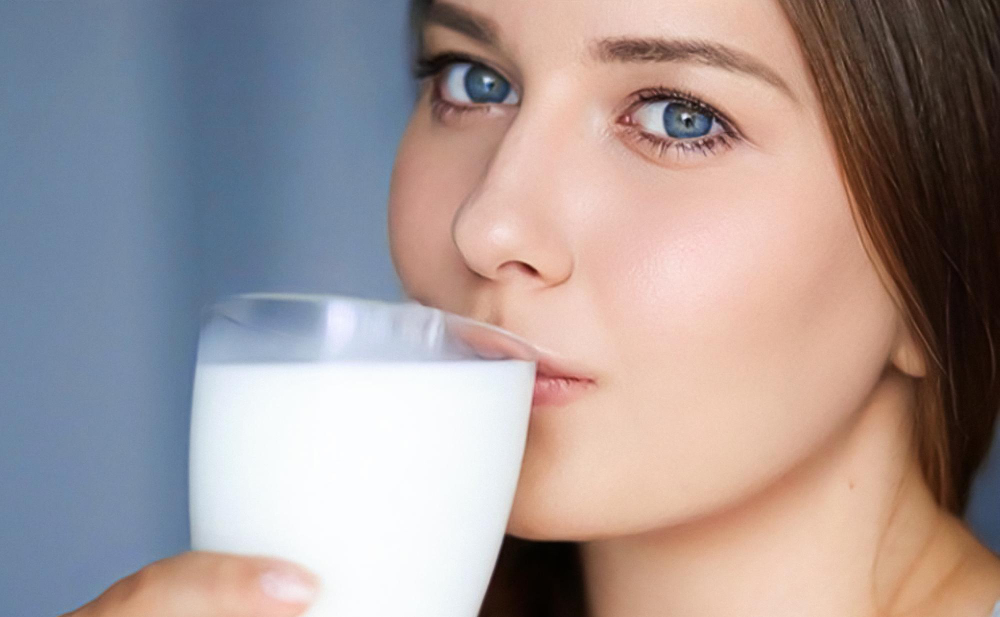Lactose-free milk - is it worth drinking?

On store shelves, we can increasingly notice lactose-free milk in addition to regular milk. Thanks to it, people with lactose intolerance can drink white coffee, eat cereal with milk or prepare classic pancakes without sacrifice. What is lactose really, what properties does it have and who does it harm? Is it worth drinking lactose-free milk? Should healthy people reach for it? How is lactose-free milk different from regular milk?
What is lactose?
Lactose is a complex sugar that is formed from the combination of two simple sugars - glucose and galactose. The compound occurs naturally in mammalian milk and can be found in such dairy products as yogurt, kefir, buttermilk, ice cream and even candy. Lactose is also an ingredient in many cheeses - we can find it in yellow cheese, feta cheese, among others.
After consuming products with lactose, it is digested by the body, which breaks it down into the previously mentioned simple sugars. In this process, the enzyme lactase plays a key role. Lactase in high amounts is found primarily in newborns and infants. As we age, the concentration of lactase decreases, making the body unable to cope with the digestion of lactose. Another cause of lactose digestion problems is also lactose intolerance.
How does lactose intolerance manifest itself?
When the body is unable to produce the right amount of lactase or does not produce it at all, we are dealing with lactose intolerance. Undigested lactose penetrates the large intestine, where various processes involving intestinal bacteria take place, including fermenting lactose into gases (carbon dioxide, hydrogen, methane) and acids (butyric acid, lactic acid, acetic acid, propanoic acid).
An abnormal reaction of the body to the consumption of lactose is mainly unpleasant discomforts of the gastrointestinal tract, such as bloating, gas, abdominal pain, diarrhea, colic or a prolonged feeling of fullness.
Lactose intolerance - can it be diagnosed?
The test used to diagnose lactose intolerance is the hydrogen breath test. In people with intolerance, hydrogen penetrates into the blood vessels and then with the blood into the lungs. During the test, air samples are taken from the patient after ingesting a dose of lactose.
Unfortunately, the test is not always reliable and sometimes the result is false negative or false positive. In addition to the test, a blood test that measures glucose levels after ingesting lactose is also applicable. If lactose is not digested, the blood glucose concentration does not rise, indicating intolerance.
Lactose intolerance and milk protein allergy
Sometimes symptoms characteristic of lactose intolerance may have another cause. Food allergies also have similar symptoms, including an allergy to milk protein. Only a proper diagnosis can pinpoint the source of the problem.
Types of lactose intolerance
We can divide lactose intolerance into two different types: primary intolerance and secondary intolerance. The former is largely genetically determined and includes food hypersensitivity caused by congenital lactase deficiency. In turn, the cause of secondary intolerance (appearing at a certain stage of life) may be, m.in. inflammatory bowel disease, alcohol abuse and infections.
How to fight lactose intolerance?
Unfortunately, there is no effective way to cure lactose intolerance. People who struggle with this condition should limit their intake of products with lactose or take lactase. In people who acquired the intolerance in adulthood, it is usually not necessary to completely give up dairy products. The most important thing is to observe the body and adjust the intake of dairy products according to the disorders present.
How is lactose-free milk made?
People suffering from lactose intolerance do not have to give up drinking milk. In stores we can find a whole range of different kinds of plant milks, as well as classic lactose-free cow's milk.
As we mentioned earlier, the enzyme lactase breaks down lactose, so we have no problem digesting it. This knowledge is used by lactose-free milk producers who add lactase to their dairy products. Contrary to popular belief, the production of lactose-free milk is not about removing lactose from the drink, but about adding an enzyme that breaks it down. Lactase causes the decomposition of lactose, i.e. breaking the bond between glucose and galactose, making milk a source of simple sugars.

Properties of lactose-free milk
Lactose-free products are not very different from their counterparts with lactose. The milk composition is virtually the same - the only difference is usually the addition of lactase.
Nutrients
Lactose-free milk contains such nutrients as its classic counterpart. These include calcium, magnesium, zinc, vitamin A, vitamin D and vitamin E.
The sweet taste of lactose-free milk
Lactose-free milks are a little sweeter and a little darker. Lactose is a milk sugar with a not very sweet taste. When it breaks down, two sweeter simple sugars are formed which are responsible for the slightly modified taste.
Higher glycemic index of lactose-free milk
It is also worth paying attention to the glycemic index of lactose-free milk, which is higher than the GI of classic cow's milk. For this reason, lactose-free milk is not recommended for people on low-GI diets and diabetics.
Who should drink lactose-free milk?
Lactose-free milk is primarily for people who are lactose intolerant. This means that they do not produce enough lactase (the aforementioned enzyme) in the intestines to deal with the breakdown of this sugar.
Who shouldn't drink lactose-free milk?
Although lactose-free milk is generally safe, it is not recommended for people struggling with sugar management disorders, such as diabetes or insulin resistance. In the case of diabetics who are lactose intolerant at the same time, it is very important to control the glycemic load of consumed products and healthy eating. What's more, classic milk should also be used by people with milk protein allergies.
Is it worth drinking lactose-free milk if you don't have an intolerance? Opinions are divided. It is likely that frequent consumption of lactose-free dairy products, such as regular milk, can lead to secondary intolerance of this sugar. If we give up lactose completely in our diet, we may also struggle with lactose intolerance in the future.
Lactase supplements for lactose intolerance
Lactose-free milk is not the only way to reduce the troublesome symptoms that occur in people with lactose intolerance. It is very often recommended to take lactase preparations. This option will work especially well for people who do not like the sweeter taste of lactose-free milk.
Dietary supplements with lactase allow you to consume regular milk. Lactase in tablet form effectively promotes the breakdown of lactose into simple sugars in the digestive tract. Thanks to this, it increases the absorption of lactose by the human body.
Lactose-free milk is definitely a convenience for anyone suffering from intolerance to this sugar. However, it should be remembered that its consumption with the restriction of products with lactose by healthy people is not recommended.
Sources:
